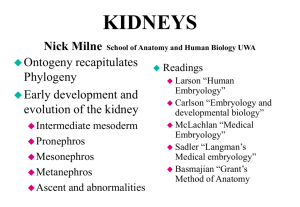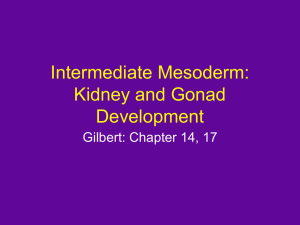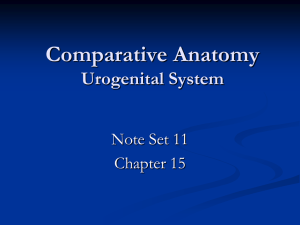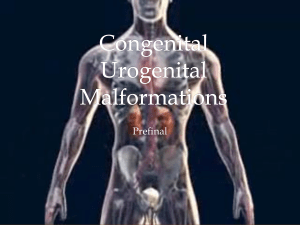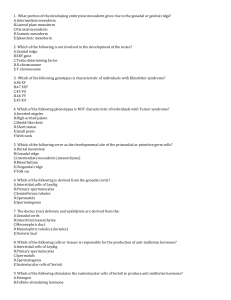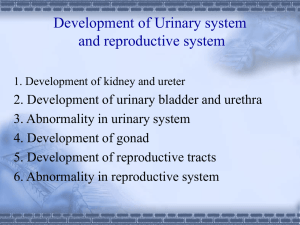KIDNEY DEVELOPMENT
advertisement
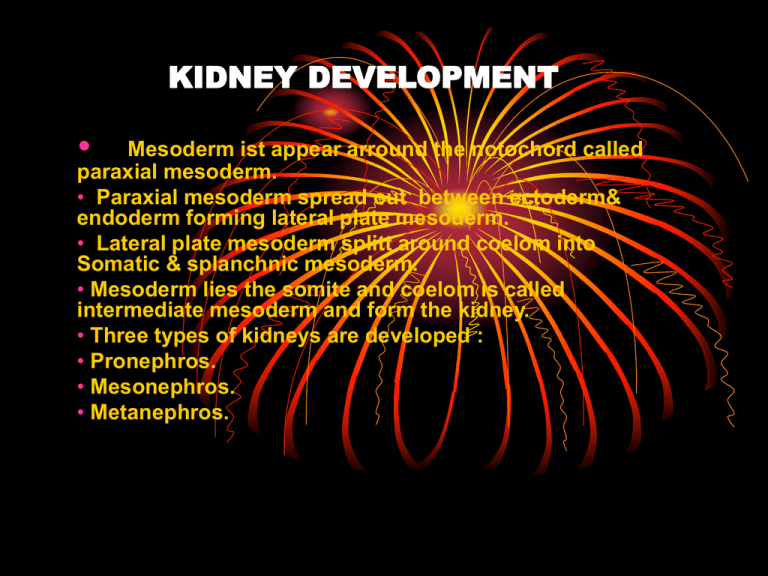
KIDNEY DEVELOPMENT • Mesoderm ist appear arround the notochord called paraxial mesoderm. • Paraxial mesoderm spread out between ectoderm& endoderm forming lateral plate mesoderm. • Lateral plate mesoderm splitt around coelom into Somatic & splanchnic mesoderm. • Mesoderm lies the somite and coelom is called intermediate mesoderm and form the kidney. • Three types of kidneys are developed : • Pronephros. • Mesonephros. • Metanephros. Pronephros Kidney • • • • • Head of kidney. Paired of pronephric tubules, one end in coelom and other in the pronephric duct. Dorsal aorta idented into the coelom ,one called internal glomeruli and other called external glomeruli. Glomeruli is civered by thin epithelium for filtration between glomeruli and coelom. Wastes passed to the internal glomerulus, then to the expanded portion of the nephrocoele (expanded portion of the pronephric tubule, then to the nephrostome. Pronephros & Mesonephros Kidney Mesonephric Kidney • Formed of 3to 4 per segment. •35-49 tubules. •Each tubule connect laterally to the mesonephric or wollfian duct. •The median end is invaginated by ba glomerulus, arrouind which a thin double-walled Bowmans capsule is formed. •Both capsule and glomerulus form the renal corpuscle. •The embryonic kidney in reptiles, birds, & mammals. The functional adult kidney in fish & amphibians . Metanephric Kidney • The adult amniote kidney • The number of corpuscles is large; up to about 4.5 million is some species • Drained by a duct called the metanephric duct or ureter • Mammalian kidneys are divided into • Cortex - contains renal corpuscles & lots of capillaries • Medulla - contains collecting ducts and loops of Henle; divided into pyramids & columns . • Pelvis - hollow; receives the urine (which exits the kidney via the ureter). • • • • 1. 2. 3. 4. Ureter bud begin to originate from the dorsal wall of the mesonephric duct. The diverticulum grow dorsal and then cranial forming the ureter. The distal blind end of this duct expand to form the renal pelvis. Differentiation of nephrons: Condensation, in which groups of about 100 cells condense tightly together to form a distinct mass . Epithelialisation, in which condensed cells lose their mesenchymal characteristics and gain epithelial ones; at the end of this period they have formed a small epithelial cyst complete with a basemement membrane, cell-cell junctions and a defined cellular apico-basal polarity . Early morphogenesis, in which the cyst invaginates twice to form a comma and then a S-shaped body, one of these invagination sites later becoming the glomerular cleft. At about this time, blood vessel progenitors invade the cleft to begin construction of the vascular component of the glomerulus. Tubule maturation, in which the sepcialised transporting segments of the nephron differentiate, and the complex morphogenesis of convoluted tubules is created
